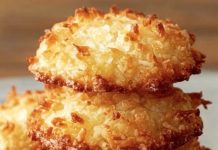- Prep Time:1 hour, 30 minutes (includes chilling)
- Cook Time:0 minutes
- Total Time:2 hours (includes chocolate setting)
- Yield:18 candies
Description
These rich and sweet Easter egg peanut butter candies combine a creamy peanut butter filling with a delicious chocolate coating. See blog post for extra tips on coating the candies with chocolate.
Ingredients
- 6 Tablespoons (85g) unsalted butter, softened to room temperature
- 1 cup (250g) creamy peanut butter (not natural style)
- 2 and 1/2 cups (300g) confectioners’ sugar
- 1/2 teaspoon pure vanilla extract
- 1/8 teaspoon salt
- 12 ounces (3 4-ounce bars) semi-sweet chocolate bars (339g), coarsely chopped*
- 1 teaspoon vegetable oil
- optional: coarse sea salt for topping
Instructions
- Line a large baking sheet with parchment paper or a silicone baking mat. Set aside.
- With a handheld or stand mixer fitted with a paddle attachment, beat the butter on medium-high speed until creamy and smooth, about 2 minutes. Add the peanut butter and beat until combined, about 1 minute. If you notice any small chunks of butter, don’t worry—the mixture will smooth out. Add the confectioners’ sugar, vanilla extract, and salt, and beat on low speed for 2 minutes until everything is combined. The mixture will be a little soft and crumbly.
- Measure 1.5 Tablespoons (about 1 ounce, or 29 grams) of peanut butter mixture. Roll into a ball. Flatten the ball between your palms and use your fingers to narrow one end into an egg shape. The egg should be roughly 3/4 inch thick. Place on the prepared baking sheet. Repeat with remaining peanut butter mixture. The mixture can be a little crumbly, but the warmth of your hands will bring it together. If you find the peanut butter mixture becoming too soft to handle, chill in the refrigerator for 15 minutes. Alternatively, you can powder your hands with confectioners’ sugar, which helps prevent the filling from sticking to your hands.
- Chill the shaped peanut butter eggs in the refrigerator for at least 1 hour and up to 1 day. During the last few minutes of the chilling time, begin melting the chocolate and oil together. You can melt it in a double boiler or the microwave. If using the microwave: place the chocolate and oil in a medium heat-proof bowl. I recommend using a liquid measuring cup because its depth makes dipping really easy. Melt in 20-second increments in the microwave, stirring after each increment, until completely melted and smooth. Let the warm chocolate sit for 6–8 minutes to cool slightly before dipping, otherwise it will melt the shaped peanut butter eggs.
- Remove peanut butter eggs from the refrigerator. Working with one at a time, submerge into the chocolate and then carefully lift out using a fork. Tap the fork gently on the side of the bowl/measuring cup to rid excess chocolate. Use a toothpick or a second fork to help slide the candy off of the fork and onto the baking sheet. If the eggs are softening and losing their shape as you’re dipping them, put the baking sheet back in the fridge for 5–10 minutes and then try again.
- If you have leftover chocolate, drizzle it over the candies. I reheat leftover chocolate and use a spoon or squeeze bottle to drizzle. If desired, lightly sprinkle each with coarse salt or festive sprinkles while chocolate is still wet.
- Refrigerate coated candies for 30 minutes or until chocolate has completely set before serving.
- Layer peanut butter eggs between sheets of parchment or wax paper and store in an airtight container in the refrigerator for up to 2 weeks. The filling can get a little soft, so they taste best right out of the refrigerator. We love them right out of the freezer, too!
Notes
- Make Ahead & Freezing Instructions: You can start this recipe 1 day ahead of time. The shaped filling can be chilled in the refrigerator for up to 1 day prior to coating. The coated peanut butter candies can be frozen. Freeze the coated candies for up to 3 months. Thaw overnight in the refrigerator.
- Butter: I use unsalted butter in this recipe, though I’ve made them plenty of times before with salted butter. No need to adjust the salt in the filling, though feel free to taste the filling before adding the salt and only add a pinch if desired. Because the filling and coating are so sweet, I never adjust the salt if using salted butter.
- Can I Use Crunchy Peanut Butter? Creamy/smooth is best because crunchy yields a very crumbly filling that’s difficult to mold. If crunchy is all you have, you can make it work in a pinch– just be warned the filling mixture will be super crumbly and you’ll really have to work it with your hands to mold into shapes.
- Chocolate: For the best looking and tasting candies, use 4-ounce “baking chocolate” bars found in the baking aisle. I prefer Bakers or Ghirardelli brands. You need 3 4-ounce bars for this recipe, 12 ounces total. You can use milk, semi-sweet, or bittersweet chocolates. (I combined 8 ounces dark and 4 ounces white chocolate to yield a lighter, milk chocolate-like coating.) You could also use chocolate melting wafers, such as Ghirardelli brand. Candy melts or almond bark work too, but they don’t taste like real chocolate. Do not use chocolate chips because they contain stabilizers preventing them from melting into the correct consistency for coating.
- Coating/Melting Chocolate: See all my troubleshooting tips above in the post.
- Do Not Temper: I do not recommend tempering the chocolate for this recipe. Tempered chocolate should not be refrigerated and due to the fresh ingredients in the filling, these candies must be refrigerated.










